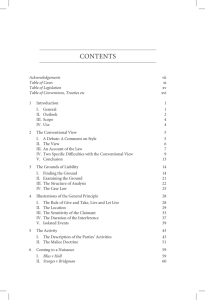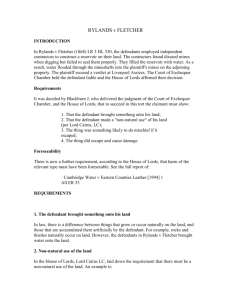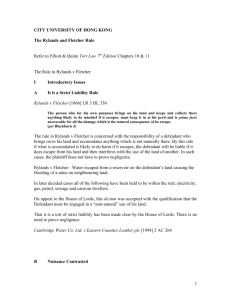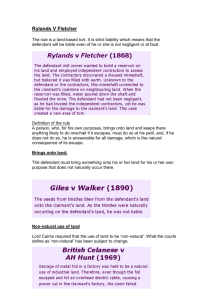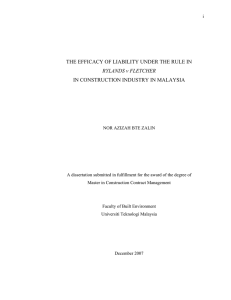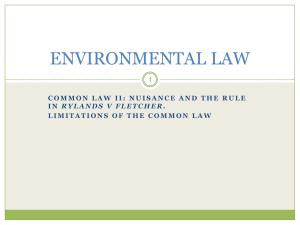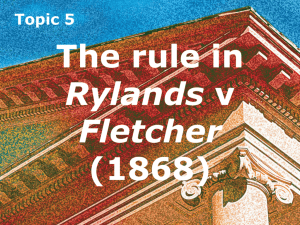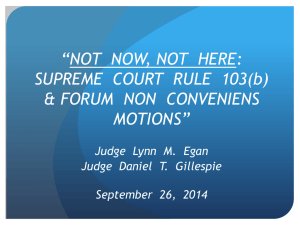Rylands PPT
advertisement
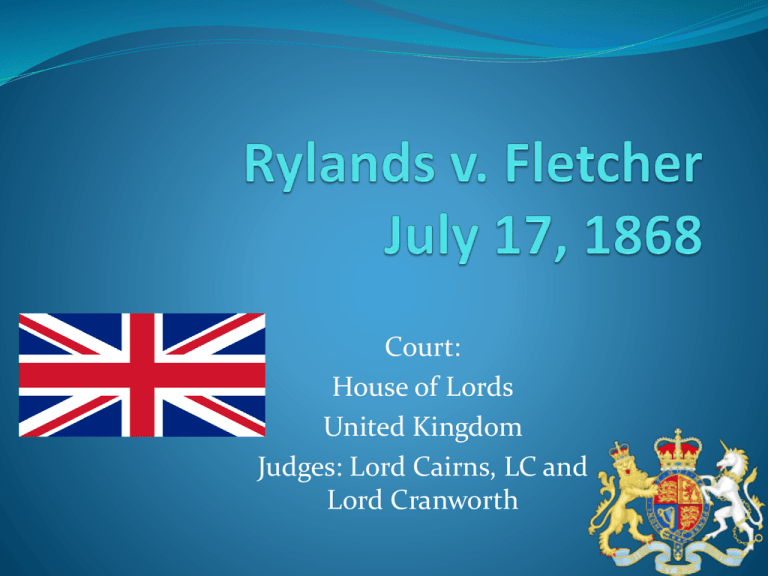
Court: House of Lords United Kingdom Judges: Lord Cairns, LC and Lord Cranworth Lord Earl Cairns Lord Baron Cranworth SUMMARY Synopsis of Rule of Law. Brief Fact Summary. A person who for his own Plaintiff sued in purposes brings on his lands and collects and keeps there anything likely to do mischief if it escapes, must keep it in at his peril, and, if he does not do so, is prima facie answerable for all the damage which is the natural consequence of its escape. connection with the flooding of his mine. The trial court found in his favor. Defendant sought review. Facts John Rylands and Thomas Fletcher were neighbors. In 1860, John Rylands paid contractors to build a reservoir on his land, intending that it should supply the Ainsworth Mill with water. Rylands played no active role in the construction, instead contracting out to a competent engineer. While building it, the contractors discovered a series of old coal shafts and passages under the land filled loosely with soil and debris, which joined up with Thomas Fletcher's adjoining mine. Rather than blocking these shafts up, the contractors left them. On December 11, 1860, shortly after being filled for the first time, Rylands's reservoir burst and flooded Fletcher's mine, the Red House Colliery, causing £937 ($1,501.50 us dollars) worth of damage. Fletcher pumped the water out, but on April 17, 1861 his pump burst, and the mine again began to flood. At this point a mines inspector was brought in, and the sunken coal shafts were discovered. Fletcher brought a claim against John Rylands, the owner, and Jehu Horrocks, the manager of Rylands's reservoir on November 4, 1861. A reservoir is a natural or artificial lake, storage pond, or impoundment from a dam which is used to store water. ISSUE FOR THE COURT Was the use of Defendant’s land unreasonable and thus was he to be held liable for damages incurred by Plaintiff? DECISION Held. The lower court judgment was affirmed, stating in essence that the Defendant’s use of the land was unreasonable, engaged in without proper caution, and resulted in harm to the Plaintiff. Concurrence. The concurrence states more clearly the rule to be applied (see above), noting also that more than the due care which was owed to plaintiff, at issue was the factual determination of damage: “[w]hen one person in managing his own affairs causes, however innocently, damage to another, it is obviously only just that he should be the party to suffer.” BLACKBURN J- Court of Exchequer Chamber We think that the true rule of law is, that the person who for his own purposes brings on his lands and collects and keeps there anything likely to do mischief if it escapes, must keep it at his peril, and, if he does not do so, is prima facie answerable for all the damage which is the natural consequence of its escape. He can excuse himself by shewing that the escape was owing to the Plaintiff’s default; or perhaps, that the escape was the consequence of vis major, or the act of God; but as nothing of this sort exists here, it is unnecessary to inquire what excuse would be sufficient. The general rule, as above stated, seems on principle just. Lord Cairns LC- HOUSE OF LORDS On the other hand if the Defendants, not stopping at the natural use of their close, had desired to use it for any purpose which I may term a non-natural use, for the purpose of introducing into the close that which in its natural condition was not in or upon it, for the purpose of introducing water either above or below ground in quantities and in a manner not the result of any work or operation on or under the land, - and if in consequence of their doing so, or in consequence of any imperfection in the mode of their doing so, the water came to escape and to pass off into the close of the Plaintiff, then it appears to me that that which the Defendants were doing they were doing at their own peril; and, if in the course of their doing it, the evil arose to which I have referred, the evil, namely, of the escape of the water and its passing away to the close of the Plaintiff and injuring the Plaintiff, then for the consequence of that, in my opinion, the Defendants would be liable. DISCUSSIONS The Rylands court considers the manner in which the Defendant used the land and concluded such use was “non-natural” what modern courts have described as inconsistent land use, i.e., when a party inflicts nonreciprocal risks on another. Nineteenth century English law was stricter than current law, in which trespass liability ordinarily requires the physical intrusion onto property, and nuisance law requires “continuing” and “permanent” activity (such as industrial activity that causes airborne pollution) RYLANDS TODAY The tort of Rylands v Fletcher has been disclaimed in various jurisdictions, including Scotland, where it was described as "a heresy that ought to be extirpated", and Australia, where the High Court chose to destroy the doctrine in Burnie Port Authority v General Jones Pty Ltd. Within England and Wales, however, Rylands remains valid law, although the decisions in Cambridge Water Co Ltd v Eastern Counties Leather plc and Transco plc v Stockport Metropolitan Borough Council make it clear that it is no longer an independent tort, but instead a sub-tort of nuisance.
